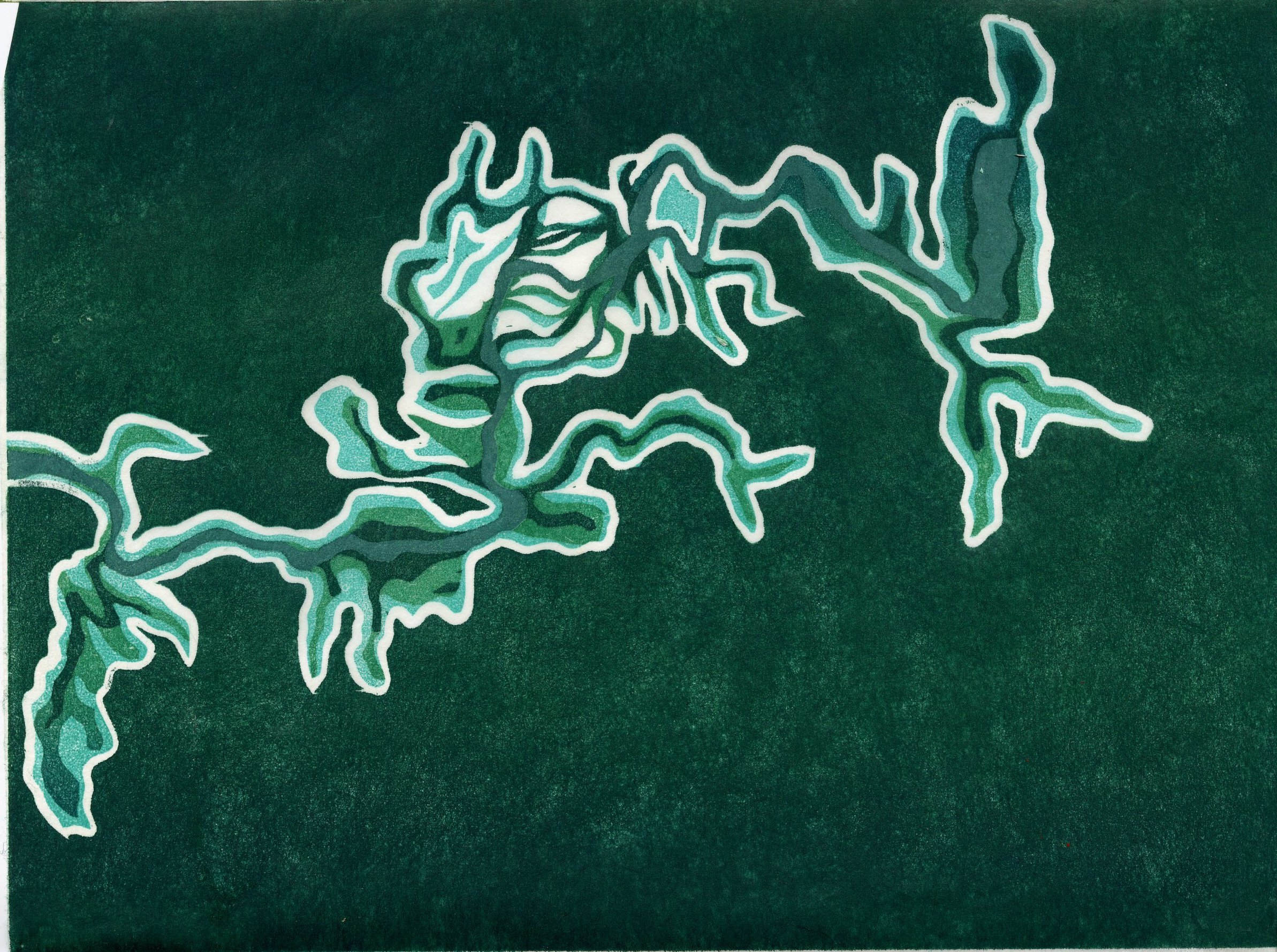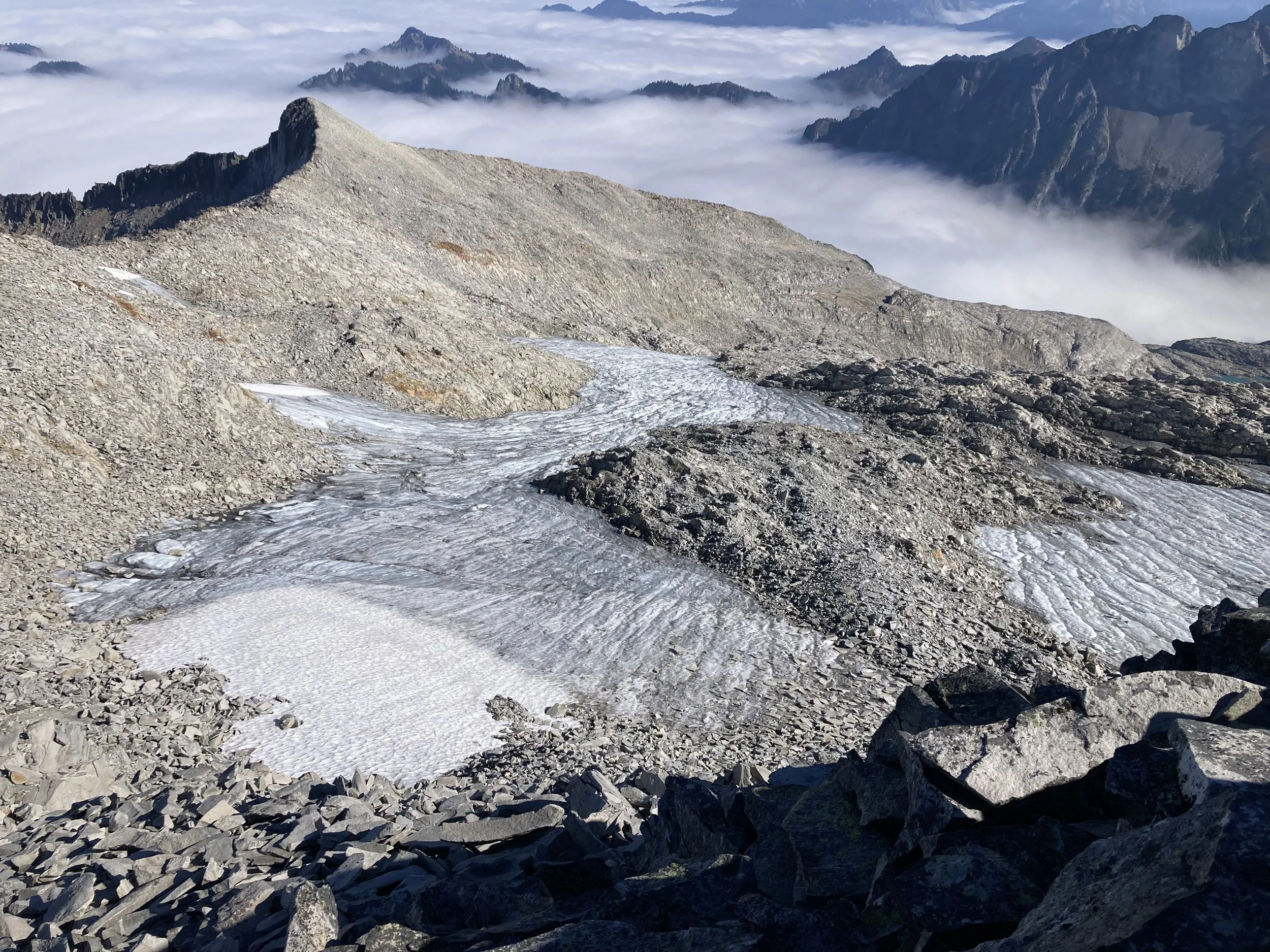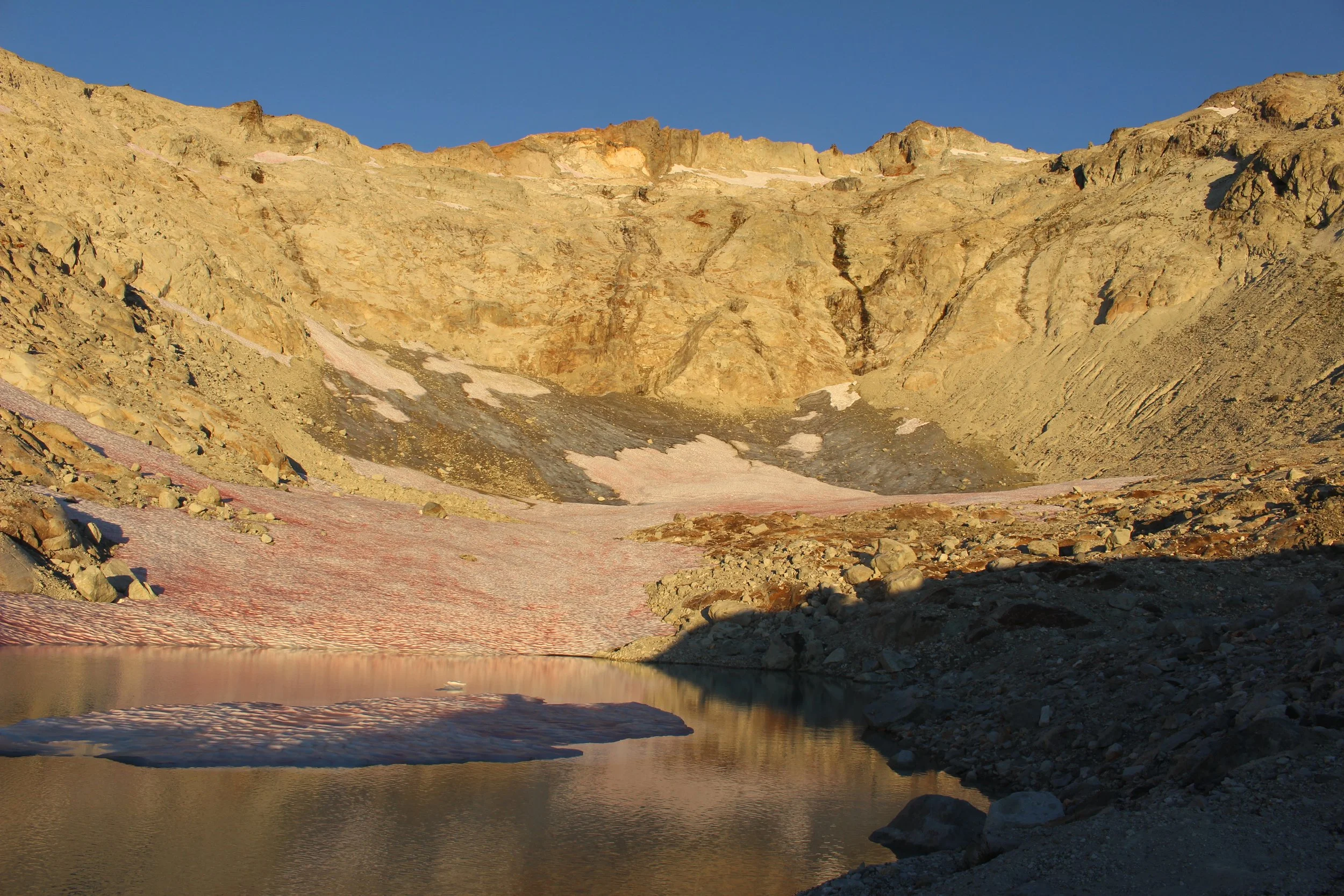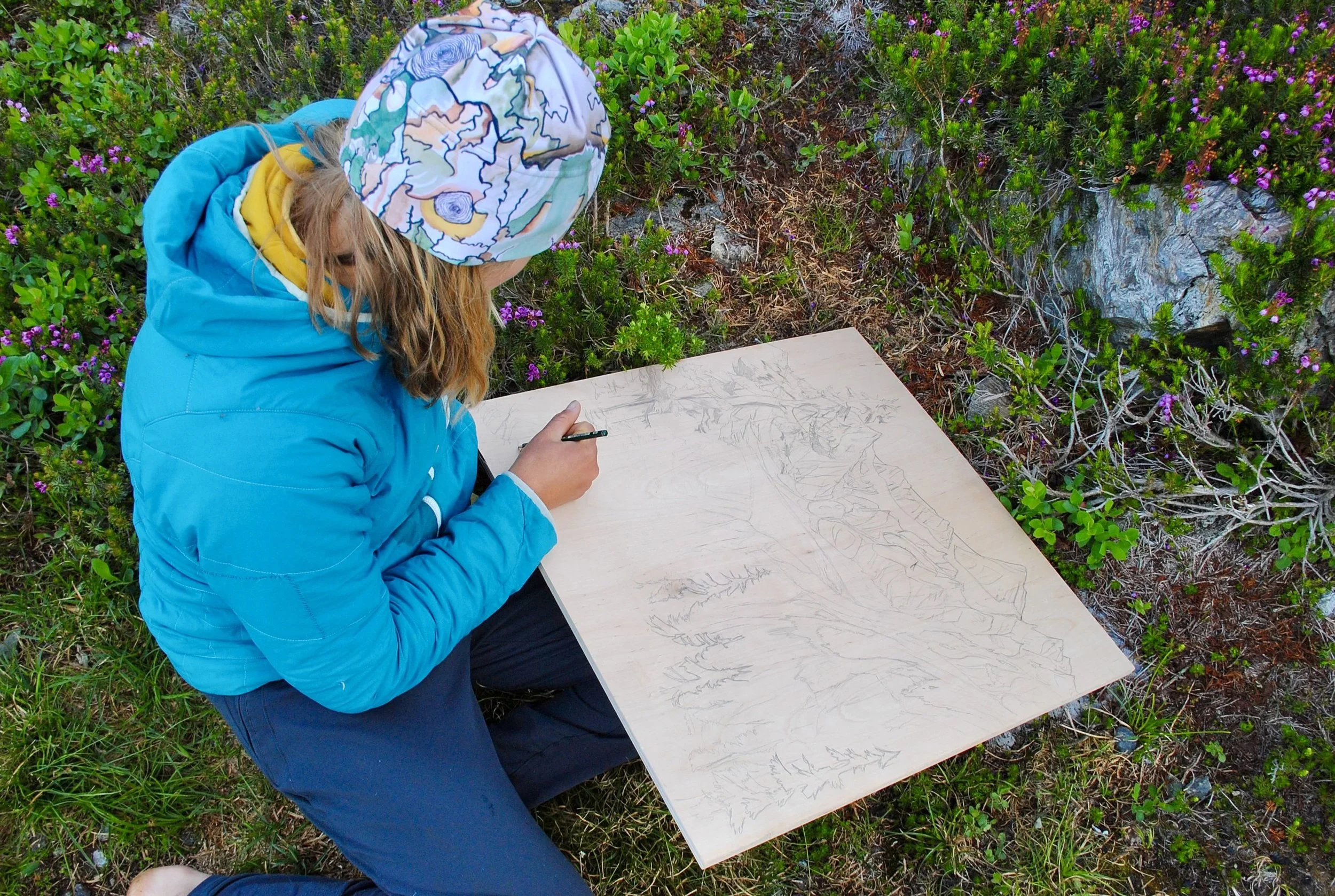
Visualizing the Range of Glaciers
This page served as a landing spot for sharing bits of my undergraduate environmental science honors thesis and related printmaking work. The North Cascades in Washington, the place I know as home, hold many glaciers that have complex ties to both ecological and human communities. Climate change is rewriting the state of these glaciers and the relationships that they can sustain. Although these connections are usually described by science, art is an expansive form of communicating a shifting landscape and its inhabitants. My project strove to explore a remarkable place in flux with various ways of knowing - scientific, personal, artistic, anecdotal. Enjoy these snippets, or download my entire thesis “Visualizing the Range of Glaciers: Science, Art and Narrative if you care to.
Happy Hydrological New Year
Remnants of the Foss Glacier on Mt. Hinman in the Alpine Lakes Wilderness, September 2025
The pace of glacier change struck me hard this summer. Never before have humans lived with such a deglaciated Cascades mountain range. Not the settlers, not the fur trappers, not the first people who have been here for 13,000 years or more. Cultures and ecosystems spawned from the retreating edge of the Cordilleran Ice sheet into the Puget Sound area. Alpine glaciers fed streams, rivers, salmon, all kinds of human projects in Washington State. Our societies are shaped by the ice and now we are experiencing glaciers disappear, quickly.
Today marks the end of the 2025 hydrological year. I am waiting for winter snow to shelter the land I love in a cool white blanket. The devastation of the alpine glaciers has surfaced so frequently in conversation these last couple months. Those who have seen the mountains are alarmed as beds of ice they once knew to be hundreds of feet thick look shallow and frail, ice pitches that were once climbed are now grey gullies of rock, and volcanoes which have always been white are unnervingly gray and shrouded in smoke. The realities of climate change in the Northwest are clear.
It is a painful time to care about the glaciers of the Cascades. Witnessing the erosion of something so much older and bigger and impactful than myself is staggering. There is much action to be done in this new terrain but for now, I come back to this: I sit in the dying glaciers warm light as the sun rises, summon the deepest snowfall in years and tell the glacier that we care, that we were grateful for all the help watering our food and feeding our oceans and making sure our salmon had somewhere to live. I am here because of you.
Sunrise hits the former Ice Worm Glacier on Mt. Daniels in the Alpine Lakes Wilderness, August 2025
Shaped by Ice
Years of thinking about glaciers and printmaking in their shadows have flown by. Nestled back at home in the Methow Valley, I’ve gotten to know my home terrain more deeply and also visited new glaciers throughout Washington, navigating amidst their collapse, learning their stories and the impacts of their melt. I’ve reconnected with the Peltos and the North Cascade Glacier Climate Project during their August field seasons. Glaciers have continued to melt - since Mauri Pelto founded the project 42 years ago, the North Cascades glaciers have lost 40-50% of their volume, with accelerated loss since 2013. Amidst all this I pushed myself to generate large woodcuts about my personal relationship with glaciers - check out my Mountains as Mirrors series.
A few steps from field visit to art gallery
I’m not the only one thinking creatively about glaciers in our present moment. Imagine a gallery full of 9 artists’ glacier-focused artwork in downtown Seattle, alluring and educating passerby with glacial blues, glacial desserts (yes, cake!) and glacial paintings. That’s exactly what Jill Pelto spearheaded with her curation of the Shaped by Ice exhibition in April 2025 at the Slip Gallery Belltown. Protect our Winters supported the show. This is the cohort of artists I am honored to create and present with:
Views from the show installation and events
Finally, the North Cascade Glacier Climate Project’s effort has been beautifully captured by Dan McComb in a short film that spotlights Jill and Mauri’s process, blending science, creativity, and community to tell the story of a rapidly changing mountain range and the people working to protect it. The second half of the film features artists involved with NCGCP, including myself.
Watch Shaped by Ice below, and share widely!
Scroll III
Scroll III. 22x80 inches: relief woodcut, acrylic intaglio, collage and chine-collé on paper, 2021. Photograph by Torsten Brinkema.
Scroll III is the unfinished, uncertain act of worlding a future North Cascades. This print arises from the world that I can imagine: detritus peeks through the delicate body of a planet sculpted by glaciers, watersheds of glacial blue burst into jumbles of light, a mangle of plastics is home to microbes. People pick up the ragged edges of the watersheds, finding solutions to the changing climate within their communities. Families gather ripe berries. In glacier-free valleys, there are no vacancies. Lichens explode over the rocks, and plants braid roots and sow seeds to the rhythms of an upward march. The world changes, cracks, burns, floods and goes on healing. Toxified ice crystals feed rumbling streams, feeding dying trees. Water in all forms is companion to life, to emergence, to death, and to decay. The pieces of the planet continue jostling because the act of becoming a world is constantly transformative.
Scroll III emerges from a soup of speculative thinking about the future of the North Cascades. Cast in jewel tones, with chaotic contrasts and novel combinations of imagery, this piece is not settled, or even sure what it is. This is fitting in that it speculates on the future impacts and possibilities of climate change. Scroll III is inspired by speculative work such as Ecosystem of Excess by Pinar Yoldas. Within visual culture, there is a need to use less familiar images to prompt new stories about climate change. ‘Classic’ images such as a pelican drenched in oil, or a shrunken glacier, sustain cynicism and climate fatigue. I linger with Yoldas’s work because she invents a completely new set of possibilities with her plastic species and organisms, enabling us to respond anew to our current predicament.
Worlding, as a verb, refers to a generative and active process. When an individual engages with a pile of interrelated happenings, a ‘world’ emerges for them (Palmer and Hunter 2018). Anderson and Harrison (2010) suggest that the world in “worlding” is “a mobile but more or less stable ensemble of practices, involvements, relations, capacities, tendencies and affordances." The process of worlding reflects individual engagement with entangled human-nature relationships. Scroll III shows my imagination acting upon the “ensemble” in the future.
Speculating Scroll III was quite challenging. I spent months trying to imagine what a “futures” glacier print would look like and I just barely made the noodly chaotic mess that is Scroll III in time for my exhibition. I found surprisingly few representations of what adaptation to climate change might look and feel like, giving me little existing material to play with, as I had with my other scrolls. I rested on my own thoughts for these speculations and returned to hopeful ideas about the “ensemble” such as: so many organisms will suck up the glacial melt water. Trees will grow thick bark, tall trunks and deep roots as they drink the runoff. Generations upon generations of people will derive meaning and sustenance and power from deglaciating landscapes. Families can harvest salmonberries, go hiking, and tend crops enriched by glacial sediment. Ecosystems and cultures are resilient and will grow around warm rivers, abundant berries and even the proliferation of microplastics. I channel these hopeful thoughts through new and old woodblocks, using vibrant color and intense compositions to highlight imminent change and possibility. Whitebark, a futures side project to Scroll III, utilizes uncanny colors and contrasting images of live and dead trees to evoke the flicker of the future: difficult to pin down, but important to imagine.
Whitebark. Relief woodcut and digital image, 2021.
Scroll III is my retaliation to the loss-centered story, the narrative that makes us lose our ability to imagine a future. It rises from my love of glaciers, and my frustration with how we tell their stories. Even though it is painful and fascinating to watch the glaciers that I love vanish, what agitates me is that we are stuck in seeing only the diminishment of ice, and not what is past it. If we are blind to emergence, we cannot orient ourselves to plan or act for the future. Scroll III embraces change. I believe change is an extremely exciting opportunity to care for each other and our world in better ways, and to listen and collaborate with one another. We won’t achieve the future we want to have if we don’t believe it is possible. And we won’t believe it if we only see diminishment. So, it is necessary for artists, science communicators, and scientists, to interpret data with optimism and imagination. “Artists believe in the future” was my motto in creating this work. In the absence of knowing exactly what monsters and gifts the Anthropocene will bear, art is necessary to think through, feel, and picture the possibilities.














